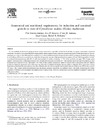Please use this identifier to cite or link to this item:
https://accedacris.ulpgc.es/jspui/handle/10553/431
| Title: | Anatomical and nutritional requirements for induction and sustained growth in vitro of Cymodocea nodosa (Ucria) Ascherson | Authors: | García-Jiménez, Pilar Pérez Navarro, Eva Santana Hernández, Cristo Luque-Escalona, Angel Robaina, Rafael R. |
UNESCO Clasification: | 241707 Algología (ficología) 241705 Biología marina |
Keywords: | Plantas Células y tejidos Cultivo Nitrógeno Propagación de la plantas, et al |
Issue Date: | 2006 | Project: | INNOVA (Fundación Universitaria de Las Palmas de Gran Canaria) | Journal: | Aquatic Botany | Abstract: | In vitro methods of plant micro-propagation are being considered as a possible solution for the decline in seagrass communities registered worldwide. To achieve successful plant micro-propagation, culture conditions are commonly adjusted empirically within almost species-specific conditions, to comply to the following three conditions: (i) culture establishment (ii) shoot production and (iii) rooting and hardening for planting in soil. Cultures ofCymodocea nodosa were established from axenic explants of the apical meristem (approx. 0.5 cm) which regenerated new leaf or produced leaf regenerating calli (5% of cultivated explants) in media containing 106 M of the cytokinin analogue TDZ. Longer ramet explants, not fully axenic, containing internode with leaf and roots were also affected by 106 M cytokinins and auxin type of regulators, as they promoted leaf extension (in cm), particularly GA. None of the explants progressed further to massive shoot propagation and new plantlet production. Instead, experiments made with ramet explants which simulated potential produced plantlet revealed that there seems to be a strong interaction within leaf, rhizome and root, since the carbon fixed in the leaf was rapidly translocated to the rest of the tissue (50% in the roots in a FW basis). The explants preferred ammonium and dihydrogen inorganic phosphate as a nutrient source, efficiently assimilating the former regardless of whether such were added to the underground or surface tissue. However, underground tissue was required to maintain P status in the cultivated explants. | URI: | https://accedacris.ulpgc.es/handle/10553/431 | ISSN: | 0304-3770 | DOI: | 10.1016/j.aquabot.2005.07.006 | Source: | Aquatic Botany [ISSN 0304-3770], v. 84 (1), p. 79-84, (Enero 2006) |
| Appears in Collections: | Artículos |
SCOPUSTM
Citations
13
checked on Jun 8, 2025
WEB OF SCIENCETM
Citations
11
checked on Jun 8, 2025
Page view(s)
141
checked on Feb 22, 2025
Download(s)
303
checked on Feb 22, 2025
Google ScholarTM
Check
Altmetric
Share
Export metadata
Items in accedaCRIS are protected by copyright, with all rights reserved, unless otherwise indicated.
